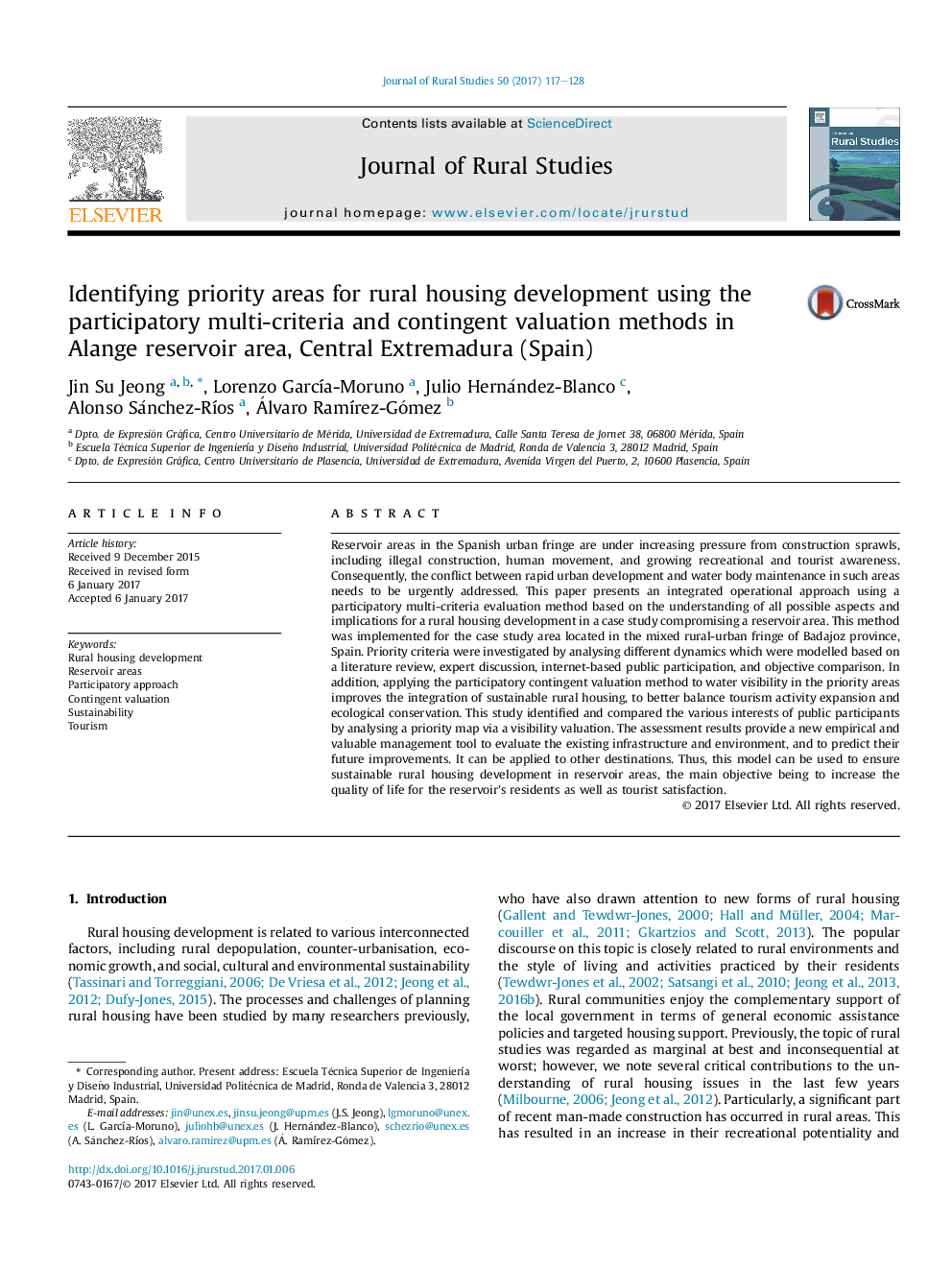| کد مقاله | کد نشریه | سال انتشار | مقاله انگلیسی | نسخه تمام متن |
|---|---|---|---|---|
| 4759950 | 1421781 | 2017 | 12 صفحه PDF | دانلود رایگان |
عنوان انگلیسی مقاله ISI
Identifying priority areas for rural housing development using the participatory multi-criteria and contingent valuation methods in Alange reservoir area, Central Extremadura (Spain)
ترجمه فارسی عنوان
شناسایی مناطق اولویتی برای توسعه مسکن روستایی با استفاده از روش های مشارکتی چند معیاره و ارزیابی احتمالی در منطقه مخزن آلانیا، اکسترامادورای مرکزی (اسپانیا)
دانلود مقاله + سفارش ترجمه
دانلود مقاله ISI انگلیسی
رایگان برای ایرانیان
کلمات کلیدی
توسعه مسکن روستایی، مناطق مخزن، رویکرد مشارکتی، ارزیابی احتمالی، پایداری، گردشگری،
ترجمه چکیده
مناطق مخزن در حاشیه شهر اسپانیایی تحت فشار فزاینده ای از فرسایش ساختمانی، از جمله ساخت و ساز غیر قانونی، جنبش انسان و افزایش آگاهی های تفریحی و گردشگری است. در نتیجه، تضاد میان توسعه سریع شهری و نگهداری بدن در چنین مناطقی، باید فورا مورد توجه قرار گیرد. این مقاله رویکرد عملیاتی یکپارچه را با استفاده از روش ارزیابی چند معیاره مشارکتی بر مبنای درک تمام جنبه های ممکن و پیامدهای توسعه مسکن روستایی در یک مطالعه موردی به خطر انداختن یک منطقه مخزن ارائه می دهد. این روش برای منطقه مورد مطالعه واقع شده در محدوده مخلوط روستایی-شهری استان والده بجوج اسپانیا اجرا شد. معیارهای اولویتی با تحلیل پویایی های مختلف که بر اساس بررسی ادبیات، بحث های متخصص، مشارکت عمومی عمومی مبتنی بر اینترنت و مقایسه ی عینی طراحی شده، مورد بررسی قرار گرفت. علاوه بر این، استفاده از روش ارزیابی احتمالی مشارکتی برای دید آب در حوزه های اولویت، ادغام روستایی پایدار روستایی را بهبود می بخشد تا بتواند با گسترش فعالیت های گردشگری و حفظ محیط زیست بهتر عمل کند. این مطالعه، شناسایی و مقابله با منافع مختلف شرکت کنندگان عمومی را با تجزیه و تحلیل یک نقشه اولویتی از طریق ارزیابی دید. نتایج ارزیابی ابزار جدید تجربی و ارزشمند برای ارزیابی زیرساخت های موجود و محیط زیست و پیش بینی پیشرفت های آینده خود را ارائه می دهد. می توان آن را به سایر مقصد اعمال کرد. بنابراین، این مدل می تواند برای اطمینان از توسعه پایدار مسکن روستایی در مناطق مخزن مورد استفاده قرار گیرد، هدف اصلی افزایش کیفیت زندگی ساکنین مخزن و همچنین رضایت گردشگری است.
موضوعات مرتبط
علوم زیستی و بیوفناوری
علوم کشاورزی و بیولوژیک
جنگلداری
چکیده انگلیسی
Reservoir areas in the Spanish urban fringe are under increasing pressure from construction sprawls, including illegal construction, human movement, and growing recreational and tourist awareness. Consequently, the conflict between rapid urban development and water body maintenance in such areas needs to be urgently addressed. This paper presents an integrated operational approach using a participatory multi-criteria evaluation method based on the understanding of all possible aspects and implications for a rural housing development in a case study compromising a reservoir area. This method was implemented for the case study area located in the mixed rural-urban fringe of Badajoz province, Spain. Priority criteria were investigated by analysing different dynamics which were modelled based on a literature review, expert discussion, internet-based public participation, and objective comparison. In addition, applying the participatory contingent valuation method to water visibility in the priority areas improves the integration of sustainable rural housing, to better balance tourism activity expansion and ecological conservation. This study identified and compared the various interests of public participants by analysing a priority map via a visibility valuation. The assessment results provide a new empirical and valuable management tool to evaluate the existing infrastructure and environment, and to predict their future improvements. It can be applied to other destinations. Thus, this model can be used to ensure sustainable rural housing development in reservoir areas, the main objective being to increase the quality of life for the reservoir's residents as well as tourist satisfaction.
ناشر
Database: Elsevier - ScienceDirect (ساینس دایرکت)
Journal: Journal of Rural Studies - Volume 50, February 2017, Pages 117-128
Journal: Journal of Rural Studies - Volume 50, February 2017, Pages 117-128
نویسندگان
Jin Su Jeong, Lorenzo GarcÃa-Moruno, Julio Hernández-Blanco, Alonso Sánchez-RÃos, Álvaro RamÃrez-Gómez,
